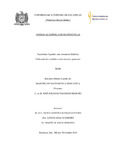
Please use this identifier to cite or link to this item:
http://ricaxcan.uaz.edu.mx/jspui/handle/20.500.11845/1215Full metadata record
| DC Field | Value | Language |
|---|---|---|
| dc.contributor | 624651 | es_ES |
| dc.contributor.advisor | Nancy Janeth Calvillo Guevara | es_ES |
| dc.contributor.author | Leticia Sosa Guerrero | es_ES |
| dc.contributor.author | Martín M. Socas Robayna | es_ES |
| dc.coverage.spatial | Zacatecas, México | es_ES |
| dc.creator | Palomino Iraburo, Jose Rolando | - |
| dc.date.accessioned | 2019-10-15T16:03:38Z | - |
| dc.date.available | 2019-10-15T16:03:38Z | - |
| dc.date.issued | 2016-12-01 | - |
| dc.identifier | info:eu-repo/semantics/publishedVersion | es_ES |
| dc.identifier.uri | http://ricaxcan.uaz.edu.mx/jspui/handle/20.500.11845/1215 | - |
| dc.description | Both numerical and figural sequences are used on secondary level students in order to visualize variables as general numbers. During there apprenticeship participants could experience different kinds of difficulties and are unable to identify the pattern that governs the succession, not coordinate the spatial structure to the number, and going from a numerical representation to an algebraic. We believe that sometimes the time devoted to this activity is not enough and exercises proposed by some teachers and some official textbooks are mostly successions of linear and numeric. Only some exercises raised are with figural sequences of type quadratic. The purpose of this research is to implement a teaching sequence in which figural succession of linear and quadratic involved in which students are able to visualize the behavior or pattern of figure and thereby have greater chances of reaching an algebraic generalization. As a model in this research Theory of Didactic Situations Brousseau that is a theory of teaching, in which mathematical objects that will teach could have an origin that is generated or built by professor were use with some intentionality. As it was proposed methodology Didactic Engineering Artigue, which consists of four phases: preliminary analysis, design and a priori analysis of teaching situations, experimentation and subsequent analysis and validation. One of the main results found is that students of junior year (aged 15 to 16 years), were able to recognize the pattern and reach the generalization of a figural succession of linear and quadratic due to the sequences used. Figural first solving a linear succession, generating a first approach, then work with quadratic succession. | es_ES |
| dc.description.abstract | Las sucesiones tanto numéricas como figurales son empleadas para que los estudiantes de nivel de secundaria logren usar la variable como número general. Durante su aprendizaje podrían experimentar diferentes tipos de dificultades como son: no identificar el patrón que rige a la sucesión, no coordinar la estructura espacial a la numérica, pasar de una representación numérica a una algebraica, entre otras. Además de esto, consideramos que en algunas ocasiones el tiempo que se dedica a esta actividad no es suficiente y desafortunadamente los ejercicios propuestos por algunos profesores y por ciertos libros de texto oficiales, son en su mayoría sucesiones del tipo lineal y numérico, sólo algunos ejercicios planteados son con sucesiones figurales del tipo cuadrático. Es por eso que el propósito de esta investigación es implementar una secuencia didáctica en la que se involucren sucesiones figurales del tipo lineal y cuadrático, en la que los estudiantes consigan por sí solos visualizar el comportamiento o el patrón de la figura y con esto tengan mayores posibilidades de llegar a una generalización algebraica. Como modelo en esta investigación se utilizó La Teoría de Situaciones Didácticas de Brousseau se trata de una teoría de la enseñanza, en la que los objetos matemáticos que se van a enseñar podrían tener un origen que sea generado o construido por el profesor, con una cierta intencionalidad. Como metodología se propuso a La Ingeniería Didáctica de Artigue, que se compone de cuatro fases: análisis preliminares, concepción y análisis a priori de las situaciones didácticas, experimentación y de análisis a posteriori y validación. Uno de los principales resultados que se encontraron es que, estudiantes de tercer año de secundaria (edades entre 15 y 16 años), lograron reconocer el patrón y llegar a la generalización de una sucesión figural del tipo lineal y cuadrático, debido a las secuencias utilizadas. Primero resolviendo una sucesión figural del tipo lineal, lo que generó un primer acercamiento, para posteriormente trabajar con la sucesión del tipo cuadrático. | es_ES |
| dc.language.iso | spa | es_ES |
| dc.publisher | Universidad Autónoma de Zacatecas | es_ES |
| dc.relation.isbasedon | Maestría en Matemática Educativa | es_ES |
| dc.relation.uri | generalPublic | es_ES |
| dc.rights | Atribución-NoComercial-CompartirIgual 3.0 Estados Unidos de América | * |
| dc.rights.uri | http://creativecommons.org/licenses/by-nc-sa/3.0/us/ | * |
| dc.subject.classification | HUMANIDADES Y CIENCIAS DE LA CONDUCTA [4] | es_ES |
| dc.subject.other | Sucesiones, | es_ES |
| dc.subject.other | variable, | es_ES |
| dc.subject.other | generalización, | es_ES |
| dc.subject.other | sucesión del tipo lineal | es_ES |
| dc.subject.other | sucesión del tipo cuadrático | es_ES |
| dc.subject.other | patrón | es_ES |
| dc.title | Sucesiones figurales, una secuencia didáctica utilizando las variables como números generales | es_ES |
| dc.type | info:eu-repo/semantics/masterThesis | es_ES |
| Appears in Collections: | *Tesis*-- UA Matemáticas | |
Files in This Item:
| File | Description | Size | Format | |
|---|---|---|---|---|
| 2016 Palomino, R..pdf | Tesis de Palomino 2016 | 5,48 MB | Adobe PDF |  View/Open |
This item is licensed under a Creative Commons License
